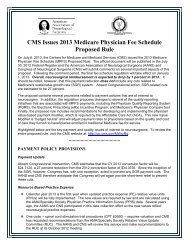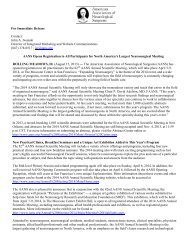view PDF - American Association of Neurological Surgeons
view PDF - American Association of Neurological Surgeons
view PDF - American Association of Neurological Surgeons
You also want an ePaper? Increase the reach of your titles
YUMPU automatically turns print PDFs into web optimized ePapers that Google loves.
When Neurosurgeons Drop<br />
What Role Might Microeconomics Play in Their Decision<br />
RICHARD N.W. WOHNS,MD,MBA<br />
Although neurosurgeons are popularly known as “brain”<br />
surgeons, anecdotal evidence and some studies suggest that<br />
at least a small number <strong>of</strong> neurosurgeons are relinquishing<br />
cranial surgery privileges. A result <strong>of</strong> taking such action is<br />
that the neurosurgeon involved no longer can cover emergency<br />
call. While cranial surgery and emergency call long have been<br />
accepted tenets <strong>of</strong> the neurosurgical pr<strong>of</strong>ession, relinquishing cranial<br />
surgery privileges is commonly thought to limit liability and<br />
help control rising medical liability insurance costs, as well as ease<br />
the surgeon’s demanding schedule.<br />
However, the underlying reason why a neurosurgeon might<br />
relinquish cranial surgery privileges may be because the microeconomics<br />
<strong>of</strong> neurosurgical practice has changed. Diminished reimbursement,<br />
particularly in the face <strong>of</strong> escalating overhead affected<br />
by high medical liability insurance premiums, means that cranial<br />
procedures now may consume more practice dollars than they generate.<br />
To illuminate the issues underlying the contentious topic <strong>of</strong><br />
dropping cranial surgery privileges, a business perspective and<br />
analysis can be applied.<br />
Devaluation and Decline <strong>of</strong> Neurosurgical Reimbursement<br />
Reimbursement for neurosurgical procedures has experienced an<br />
overall decline in recent years. After reimbursement values reached<br />
their maximum in 1997, cranial surgery values fell about 25 percent<br />
and spinal surgery values, about 30 percent. The reimbursement<br />
reductions primarily were due to Medicare’s transition to the<br />
resource-based relative value scale between 1999 and 2002.<br />
Since 1992, reimbursement for spinal procedures fell more than<br />
for cranial procedures in most cases. An example <strong>of</strong> the reimbursement<br />
decline for spinal procedures is the 30 percent reduction for<br />
code 63047 (lumbar laminectomy) from $1,408 in 1992 to $1,010<br />
in 2003. (Code 22612 for posterolateral fusion is an exception.<br />
Reimbursement for this code increased from $1,255 in 1992 to<br />
$1,372 in 2004.) Cranial surgery reimbursement remained<br />
unchanged or even increased slightly from 1992 to 2004, but there<br />
was a significant reduction in the real dollar value. This is due to<br />
lack <strong>of</strong> any adjustment for inflation, cost <strong>of</strong> living or practice overhead<br />
increase. Several examples <strong>of</strong> reimbursement for cranial procedures<br />
per Current Procedural Terminology Code are: code 61313<br />
(craniotomy for intracranial hemorrhage)—$1,600 in 1992, and<br />
$1,662 in 2003; code 61312 (craniotomy for subdural hematoma)—<br />
$1,605 in 1992, and $1,654 in 2004; and code 61512 (craniotomy for<br />
meningioma)—$1,913 in 1992, and $2,315 in 2003.<br />
The Cost <strong>of</strong> Lost Opportunity<br />
In addition to the rate <strong>of</strong> reimbursement, the time and expense<br />
involved in performing each surgical procedure must be assessed.<br />
The time and expense spent in the total provision <strong>of</strong> cranial surgery<br />
exceeds that spent in spinal surgery. Therefore, when neurosurgeons<br />
forego the revenues generated from spinal surgeries to perform cranial<br />
surgeries, they are experiencing the phenomenon <strong>of</strong> “opportunity<br />
cost.” This particularly is the experience when emergency<br />
cranial surgeries cause cancellation <strong>of</strong> elective spinal surgeries.<br />
A neurosurgical practice that primarily focuses on spinal surgery<br />
not only is efficient, but there also is very little adverse impact on<br />
the pr<strong>of</strong>itability <strong>of</strong> a practice that does not include brain surgery<br />
and emergency coverage. An analysis <strong>of</strong> the opportunity cost and<br />
microeconomics <strong>of</strong> neurosurgical practice illustrates the contrast in<br />
pr<strong>of</strong>itability between cranial and spinal surgery.<br />
Marginal Revenue, Marginal Cost, and Pr<strong>of</strong>it Maximization<br />
When businesses have a product with diminishing pr<strong>of</strong>itability and<br />
other products with greater pr<strong>of</strong>itability, the decision <strong>of</strong>ten is made<br />
to drop the less pr<strong>of</strong>itable product. The decision hinges on the marginal<br />
revenue <strong>of</strong> the product, whether the business is running at<br />
capacity, and the supply and demand for products. If the business<br />
is not running at capacity and the devalued product helps to cover<br />
fixed expenses, then good business practice supports continuing<br />
with that product line. However, if the business is running at capacity<br />
and there is strong demand for the products, then good business<br />
practice supports dropping the less pr<strong>of</strong>itable product.<br />
As the business increases its level <strong>of</strong> output, each additional unit<br />
adds to the total revenue <strong>of</strong> the business. The additional revenue<br />
attributable to producing one more unit <strong>of</strong> output is called marginal<br />
revenue. As the business increases its level <strong>of</strong> output, each unit<br />
increase in output increases the business’s total cost. The additional<br />
cost <strong>of</strong> producing one more unit <strong>of</strong> output is called marginal cost.<br />
In the special case in which the price <strong>of</strong> the commodity is given to<br />
the business by the market, marginal revenue equals price. For<br />
example, if the business produces plywood, and the market price <strong>of</strong><br />
plywood is $300 per 1,000 square feet, the marginal revenue from<br />
each additional thousand square feet is $300. The business would<br />
increase plywood production—and maximize pr<strong>of</strong>it—as long as<br />
the marginal cost <strong>of</strong> each additional thousand square feet is less<br />
than $300. The business would not increase production if cost <strong>of</strong><br />
each additional thousand square feet is more than $300 to produce.<br />
The principle <strong>of</strong> pr<strong>of</strong>it maximization is germane to a neurosurgical<br />
practice. The reasoning used by businesses that choose<br />
30 AANS Bulletin • www.AANS.org

















